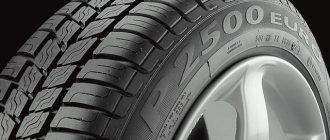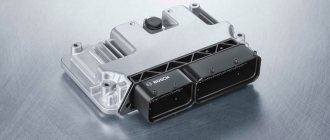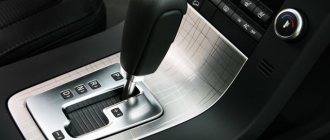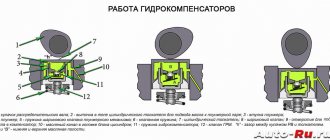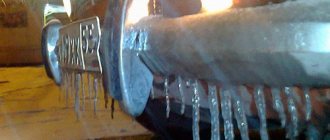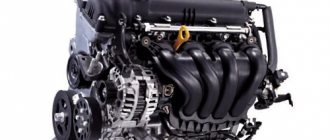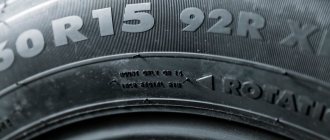Today, you can find a huge variety of car tires in the arsenal of car stores. They all have different characteristics and differ in appearance. However, for those who are not well versed in this issue, I would like to note that there are two types of tires: either radial or diagonal. But before understanding the differences between these two types of tires, it would be appropriate to understand in general how the tire is constructed. Absolutely any tire for a car consists of a frame that strengthens the tire. It also has a breaker that ensures a smooth transition from the carcass to the outer layer of the tire. It is the breaker that takes on the wheel load. A tread is provided for direct contact with the road surface.
Radial tires: what are they?
Radial tires usually have carcass threads made of steel or polymer. They run in a radial direction from the side of the tire and towards its profile. The threads intersect and lie parallel in each layer of the tire. Radial tires have one bead ring. These tires have a sufficient number of advantages, but the most notable among them are their long service life, low rolling resistance and a rapid drop in pressure in the event of a tire puncture. The latter allows the driver to go to a tire shop and correct the situation. Radial tires also have fewer belt layers, which results in greater thermal energy dissipation when the tire is shaded. In addition, such tires have a much larger tread contact patch, and therefore have better grip on the road surface.
Pros and cons of radial and bias tires in construction
Radial tires continue to increase their market share in the heavy off-road segment as the number of companies appreciating them continues to grow.
In America and Europe, the distribution of market coverage for both types of tires on construction sites is still approximately the same, but the share of radial tires is gradually increasing. In Russia, diagonal ones are still in great demand. But it’s interesting how quickly the Western trend will spread on our construction sites.
Your choice of both radial and bias-ply tires for special equipment starts here
There is a pattern: the larger the equipment, the more often you can find radial tires on it. In the West, they believe that their dominance in the construction industry is only a matter of time.
Thomas Bennett, a representative of Michelin, describes the current state of affairs as follows: for vehicles with size 23.5-25 and smaller, radial tires now account for about 40%, but in the large-size segment (26.5, 29.5) the percentage reaches 50/50, and for large quarry tires cars – about 80%.
Diagonal tires: features and benefits
The cords in bias-ply tires are woven in pairs. They are located diagonally from one side to the other. The cords in bias-ply tires intersect at an angle in the tread area. Tires have two bead rings. These tires are designed for installation on special equipment, in particular tractors or loaders. Among the advantages of such tires is the simple design of the tires, due to which their cost is much lower. The side part of a bias-ply tire has high strength and such a tire can also actively absorb loads if the wheel falls into a hole. Diagonal tires are suitable for repair.
More information about which tires are better, radial or diagonal, will be discussed in this video:
Published: May 14, 2020
Diagonal and radial tires - what are the differences?
Today it is difficult to imagine a vehicle that does not move on tires, with the exception of special vehicles on caterpillar tracks. A person who does not encounter them often will say that the tires differ only in size and tread pattern. But no matter how it is! The differences are huge: from the type of construction to the rubber compounds. But let's take things in order. An important criterion when choosing a wheel is the type of design, and we start from it. Then the next question arises: what type do you need? The answer to this question follows from the differences that we will look at in this article.
Fig.1 Type of frames
Diagonal tires have a carcass that consists of several layers of cord, multiples of two. The cord threads intersect at an angle relative to each other (35°-40°) in the middle of the running track (tread).
Tires with a diagonal frame have a strong sidewall, so they are not afraid of side impacts and cuts. They are well suited for all types of work and types of transport, unless they are used for long-term plowing or driving on roads with good surfaces. In cases where this is done for a short time, they perform well without losing their qualities. These tires are approximately 30-40% cheaper than radial tires, but the average mileage is 20 - 40,000 km.
For radial tires, the cord threads are stretched between the sidewalls without overlapping each other. The frame shell is covered with a flexible belt (a belt made of inextensible flexible textile cord)
Fig.2 Design of radial tires. 1) Frame; 2) Breaker belt; 3) Frame.
A radial tire has the designation R (Radial) in the size label on the side of the wheel. Due to higher wear resistance, compared to bias-ply tires, the average mileage of a radial tire is 60 – 80,000 km.
Fig.3 Contact patch of diagonal and radial tires.
A radial tire has a larger contact patch than a similar bias-ply tire. Because of this, they are preferable in cases where good and stable traction on soft soil is needed, as well as for frequent and long journeys on good quality roads.
Below are tables that will help you understand the speed and load-bearing capacity indices.
Speed category index:
| Speed index | Maximum speed, km/h |
| A1 | 5 |
| A2 | 10 |
| A3 | 15 |
| A4 | 20 |
| A5 | 25 |
| A6 | 30 |
| A7 | 35 |
| A8 | 40 |
| B | 50 |
| C | 60 |
| D | 65 |
| E | 70 |
| F | 80 |
| G | 90 |
| J | 100 |
| K | 110 |
| L | 120 |
| M | 130 |
| N | 140 |
| P | 150 |
Load bearing index:
| Ind. | Load kg | Ind. | Load kg | Ind. | Load kg | Ind. | Load _ kg | Ind. | Load kg | Ind. | Load kg |
| 50 | 190 | 74 | 375 | 98 | 750 | 122 | 1500 | 146 | 3000 | 170 | 6000 |
| 51 | 195 | 75 | 387 | 99 | 775 | 123 | 1550 | 147 | 3075 | 171 | 6150 |
| 52 | 200 | 76 | 400 | 100 | 800 | 124 | 1600 | 148 | 3150 | 172 | 6300 |
| 53 | 206 | 77 | 412 | 101 | 825 | 125 | 1650 | 149 | 3250 | 173 | 6500 |
| 54 | 212 | 78 | 425 | 102 | 850 | 126 | 1700 | 150 | 3350 | 174 | 6700 |
| 55 | 218 | 79 | 437 | 103 | 875 | 127 | 1750 | 151 | 3450 | 175 | 6900 |
| 56 | 224 | 80 | 450 | 104 | 900 | 128 | 1800 | 152 | 3550 | 176 | 7100 |
| 57 | 230 | 81 | 462 | 105 | 925 | 129 | 1850 | 153 | 3650 | 177 | 7300 |
| 58 | 236 | 82 | 475 | 106 | 950 | 130 | 1900 | 154 | 3750 | 178 | 7500 |
| 59 | 243 | 83 | 487 | 107 | 975 | 131 | 1950 | 155 | 3875 | 179 | 7750 |
| 60 | 250 | 84 | 500 | 108 | 1000 | 132 | 2000 | 156 | 4000 | 180 | 8000 |
| 61 | 257 | 85 | 515 | 109 | 1030 | 133 | 2060 | 157 | 4125 | 181 | 8250 |
| 62 | 265 | 86 | 530 | 110 | 1060 | 134 | 2120 | 158 | 4250 | 182 | 8500 |
| 63 | 272 | 87 | 545 | 111 | 1090 | 135 | 2180 | 159 | 4375 | 183 | 8750 |
| 64 | 280 | 88 | 560 | 112 | 1120 | 136 | 2240 | 160 | 4500 | 184 | 9000 |
| 65 | 290 | 89 | 580 | 113 | 1150 | 137 | 2300 | 161 | 4625 | 185 | 9250 |
| 66 | 300 | 90 | 600 | 114 | 1180 | 138 | 2360 | 162 | 4750 | 186 | 9500 |
| 67 | 307 | 91 | 615 | 115 | 1215 | 139 | 2430 | 163 | 4875 | 187 | 9750 |
| 68 | 315 | 92 | 630 | 116 | 1250 | 140 | 2500 | 164 | 5000 | 188 | 10000 |
| 69 | 325 | 93 | 650 | 117 | 1285 | 141 | 2575 | 165 | 5150 | 189 | 10300 |
| 70 | 335 | 94 | 670 | 118 | 1320 | 142 | 2650 | 166 | 5300 | 190 | 10600 |
| 71 | 345 | 95 | 690 | 119 | 1360 | 143 | 2725 | 167 | 5450 | 191 | 10900 |
| 72 | 355 | 96 | 710 | 120 | 1400 | 144 | 2800 | 168 | 5600 | — | — |
| 73 | 365 | 97 | 730 | 121 | 1450 | 145 | 2900 | 169 | 5800 | — | — |
03/31/2016
FOR THE AUTHOR PRINT TEXT
RUBRIC: Tires
Some features of different types of tires
Among the types of tires used for loading equipment, there are pneumatic, solid and bandage tires. Pneumatic tires, in turn, are radial and diagonal. Solid, radial, and bias-ply tires for special equipment have their advantages.
It is possible to say which tire is better only taking into account the expected operating conditions. Pneumatics provide better shock absorption; the air inside the air chamber of a pneumatic tire maintains its shape and allows the wheel to withstand the calculated load. Due to the fact that the pneumatic tire protects the undercarriage of the loader from wear, softening shocks and shocks, it becomes possible to operate equipment on pneumatic tires in any difficult conditions, on surfaces with uneven terrain, on construction sites.
Classification and designation of tires, tire wear, permissible tire tread depth, wheel markings. Tire operation.
Diagonal tires
Why are they called this:
In ply-ply tires (called bias-ply tires), the cords in the carcass layers run diagonally from bead to bead. Due to the need to cross paths in two adjacent layers of the frame, the number of layers must be even: 2,4,6,8.
Advantages of bias tires.
It should be noted that such tires have their own advantages: Firstly, diagonal tires have a simpler design, and therefore lower price and lower repair complexity. Secondly, higher strength of the side walls (sidewalls). Thirdly, better mitigation of shock loads transmitted to the car when driving on roads with small potholes, when moving over seams of the road surface.
Disadvantages of bias tires:
On a bias-ply tire, when the load changes during vibrations while driving, the tread is subject to increased deformation (“collapse”), as a result of which the grooves of the pattern are compressed and the protrusions slip along the supporting surface.
Diagonal tires are inferior in performance to radial tires.
Radial tires
Why are they called this:
In radial tires, the cord threads in the carcass layers do not intersect like in diagonal tires, but have a radial (meridional) arrangement, i.e. directed from side to side.
Tires with radial cords in the carcass (radial tires) are available in tubed and tubeless versions.
The breaker in such tires performs most of the work of the frame and is most often made of 2…3 layers of steel cord.
Metal cord is a thin cable consisting of brass-plated steel wires with a diameter of 0.15...0.25 mm. Metal cord is characterized by high strength, low elongation compared to textile cord, has high resistance to thermal aging and better thermal conductivity.
Radial tires are available in two types: - with a synthetic fiber cord in the carcass and with a metal cord in the belt (combined); — with a cord made of synthetic fibers in the frame and textile fibers in the breaker
The nylon cord in the carcass and the metal cord in the breaker make it possible to increase the strength of the tire in the treadmill area, protect its frame from damage, and reduce the spread of cracks in the tread.
Pros of radial tires:
The frame threads only support radial loads. And this, in comparison with diagonal tires, significantly reduces the tension of the threads and allows, under the same load, to produce the frame of radial tires with less ply (twice), which ensures better heat dissipation.
The number of layers in the carcass of radial tires can be odd, since each layer of cord works independently due to the radial direction of the threads (The number of layers and what they are from can be read on the sidewall of the tire and from there draw conclusions about the strength of the tire).
It should be noted that radial tires have better grip on the road surface than diagonal tires. This is achieved due to a larger contact area with the supporting surface and the use of a breaker made of super-modular types of cord (steel cord, etc.)
For radial tires, a rigid belt reduces tread deformation and the contact patch remains virtually unchanged in shape. Therefore, the groove volume does not decrease and the tread ridges do not slip.
Radial tires, compared to diagonal tires, are characterized by a greater load-bearing capacity (by 15...20%); increased maximum speed; less weight (by 3…4%); greater radial elasticity (by 20...30%), less heating (by 20...30%).
Radial tires increase the safety of vehicle operation by: - improving stability and controllability when driving; — increased grip on roads with dry and wet surfaces; reducing the risk of mechanical damage and punctures in the tread area
Cons of radial tires:
However, radial tires have a higher cost and increased lateral elasticity. The radial arrangement of the cord threads reduces the strength of the sidewall of the tire wall. In difficult road conditions when driving on deep ruts, especially with low air pressure in the tires, when hitting curbs, the sidewalls of radial tires, compared to diagonal tires, are more often damaged.
Diagonal tires are inferior in performance to radial tires.
At the moment, if you go to any of the stores to purchase tires for your passenger car, you will be offered a radial tubeless tire because This is the most common type of tire present on the automotive market today. If you are buying a car for a truck, for example, then options are possible.
Radial
The cord, located radially between the carcass rubber layers, provides better contact with the track due to greater contact. Basically, they don't use a camera and have soft sides that soften the impact on uneven surfaces. High thermal conductivity provides good traction, which allows the car to have good maneuverability at high speeds.
Thanks to the uniform load over the entire tread surface, its service life is significantly increased. It is these indicators, which are more suitable for passenger cars, that have made them so popular. Almost all new passenger cars are equipped with them.
It is impossible to single out a specific type due to the distinctive areas of application. Depending on the type of car and future operating conditions, as well as the time of year, select the appropriate tires. Wear resistance depends only on the manufacturers. Prices can vary enormously, depending on the materials used, but Thompson's design idea cannot be surpassed to this day.
